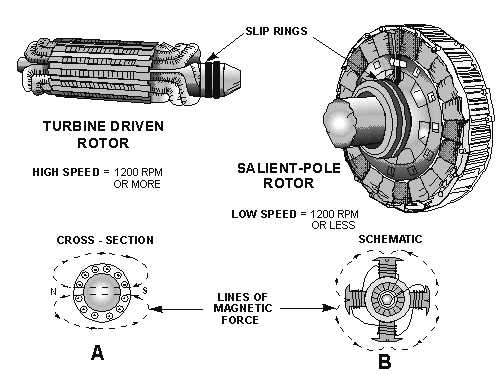3-6
PRIME MOVERS
All generators, large and small, ac and dc, require a source of mechanical power to turn their rotors.
This source of mechanical energy is called a prime mover.
Prime movers are divided into two classes for generators-high-speed and low-speed. Steam and gas
turbines are high-speed prime movers, while internal-combustion engines, water, and electric motors are
considered low-speed prime movers.
The type of prime mover plays an important part in the design of alternators since the speed at which
the rotor is turned determines certain characteristics of alternator construction and operation.
ALTERNATOR ROTORS
There are two types of rotors used in rotating-field alternators. They are called the turbine-driven and
salient-pole rotors.
As you may have guessed, the turbine-driven rotor shown in figure 3-4, view A, is used when the
prime mover is a high-speed turbine. The windings in the turbine-driven rotor are arranged to form two or
four distinct poles. The windings are firmly embedded in slots to withstand the tremendous centrifugal
forces encountered at high speeds.
Figure 3-4.—Types of rotors used in alternators.
The salient-pole rotor shown in figure 3-4, view B, is used in low-speed alternators. The salient-pole
rotor often consists of several separately wound pole pieces, bolted to the frame of the rotor.
If you could compare the physical size of the two types of rotors with the same electrical
characteristics, you would see that the salient-pole rotor would have a greater diameter. At the same
number of revolutions per minute, it has a greater centrifugal force than does the turbine-driven rotor. To


